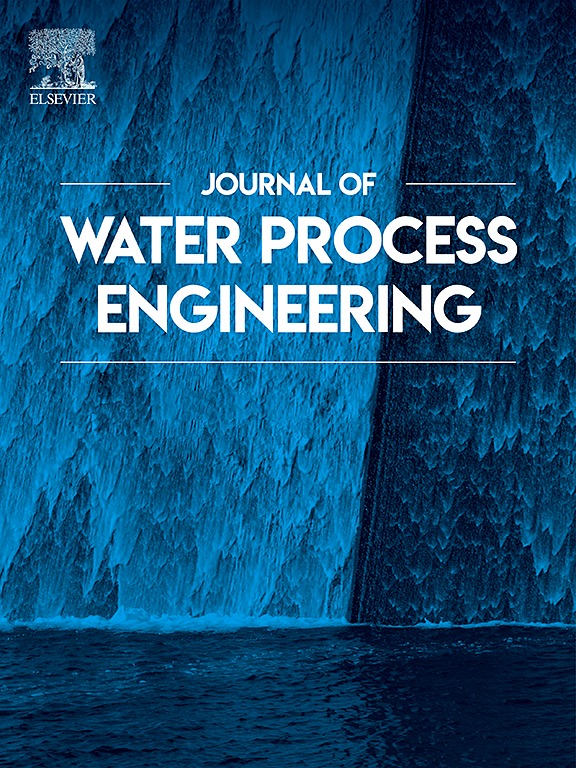Photochemistry of Lake Taihu dissolved organic matter: Reactive species generation and effects on microcystin photodegradation
IF 6.3
2区 工程技术
Q1 ENGINEERING, CHEMICAL
引用次数: 0
Abstract
Dissolved organic matter (DOM) plays crucial roles in photochemical processes through light-induced transformations and reactive species generation. Four types – cyanobacteria extract from Lake Taihu (CDOM), reed leaf extract from Lake Taihu (RDOM), sodium humate (HA), and fulvic acid (FA) – were studied. The main component of all four DOM was humic acid-like, with fluorescence intensity reduced under light. Fourier-transform ion cyclotron resonance mass spectrometr (FT-ICR MS) revealed CDOM, RDOM, and FA contained abundant CHON and CHONS compounds, while HA was rich in CHO. Light exposure increased the number of molecular formulae in CDOM, RDOM, and FA. The unsaturation of CDOM, RDOM, and HA increased, while FA decreased. All DOM had high lignin abundance, with CDOM and RDOM also high protein and lipid. Lignin-like compounds decreased after 10 h light. DOM undergoes photochemical reactions under light to produce various reactive species, mainly excited triplet DOM (3DOM⁎), hydroxyl radicals (·OH) and singlet oxygen (1O2), CDOM produces the most ∙OH and 3DOM⁎, and HA produces the most 1O2. All four DOM types enhanced microcystin-LR (MCLR) photodegradation compared to no DOM, with FA showing the strongest promotion (29.2 % degradation). FA photolysis yielded higher ·OH and 1O2, it was speculated that the conversion of 3DOM⁎ to ·OH and 1O2 may significantly impacts MCLR degradation. This study elucidates the differential effects of DOM from different sources on the photodegradation efficiency of MCLR due to their molecular composition and photochemical properties.

太湖溶解有机物的光化学:活性物质的产生及其对微囊藻毒素光降解的影响
溶解有机物(DOM)通过光诱导转化和反应物质生成在光化学过程中起着至关重要的作用。以太湖蓝藻提取物(CDOM)、太湖芦苇叶提取物(RDOM)、腐植酸钠(HA)和黄腐酸(FA)为研究对象。4种DOM的主要成分均为腐植酸样,光照下荧光强度降低。傅里叶变换离子回旋共振质谱(FT-ICR MS)显示,CDOM、RDOM和FA中含有丰富的CHON和CHONS化合物,HA中含有丰富的CHO。光照增加了CDOM、RDOM和FA的分子式数量。CDOM、RDOM和HA的不饱和度升高,FA降低。所有DOM均具有较高的木质素丰度,CDOM和RDOM也具有较高的蛋白质和脂质丰度。光照10 h后木质素类化合物减少。DOM在光照下发生光化学反应,产生多种活性物质,主要是激发三重态DOM (3DOM)、羟基自由基(·OH)和单线态氧(1O2), CDOM产生的∙OH和3DOM最多,HA产生的1O2最多。与不含DOM相比,4种DOM均增强了微囊藻毒素- lr (MCLR)的光降解,其中FA的促进作用最强(降解率为29.2%)。FA光解产生较高的·OH和1O2,推测3DOM转化为·OH和1O2可能会显著影响MCLR的降解。本研究阐明了不同来源的DOM由于其分子组成和光化学性质对MCLR光降解效率的差异影响。
本文章由计算机程序翻译,如有差异,请以英文原文为准。
求助全文
约1分钟内获得全文
求助全文
来源期刊

Journal of water process engineering
Biochemistry, Genetics and Molecular Biology-Biotechnology
CiteScore
10.70
自引率
8.60%
发文量
846
审稿时长
24 days
期刊介绍:
The Journal of Water Process Engineering aims to publish refereed, high-quality research papers with significant novelty and impact in all areas of the engineering of water and wastewater processing . Papers on advanced and novel treatment processes and technologies are particularly welcome. The Journal considers papers in areas such as nanotechnology and biotechnology applications in water, novel oxidation and separation processes, membrane processes (except those for desalination) , catalytic processes for the removal of water contaminants, sustainable processes, water reuse and recycling, water use and wastewater minimization, integrated/hybrid technology, process modeling of water treatment and novel treatment processes. Submissions on the subject of adsorbents, including standard measurements of adsorption kinetics and equilibrium will only be considered if there is a genuine case for novelty and contribution, for example highly novel, sustainable adsorbents and their use: papers on activated carbon-type materials derived from natural matter, or surfactant-modified clays and related minerals, would not fulfil this criterion. The Journal particularly welcomes contributions involving environmentally, economically and socially sustainable technology for water treatment, including those which are energy-efficient, with minimal or no chemical consumption, and capable of water recycling and reuse that minimizes the direct disposal of wastewater to the aquatic environment. Papers that describe novel ideas for solving issues related to water quality and availability are also welcome, as are those that show the transfer of techniques from other disciplines. The Journal will consider papers dealing with processes for various water matrices including drinking water (except desalination), domestic, urban and industrial wastewaters, in addition to their residues. It is expected that the journal will be of particular relevance to chemical and process engineers working in the field. The Journal welcomes Full Text papers, Short Communications, State-of-the-Art Reviews and Letters to Editors and Case Studies
 求助内容:
求助内容: 应助结果提醒方式:
应助结果提醒方式:


